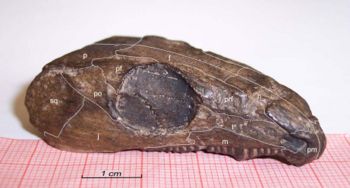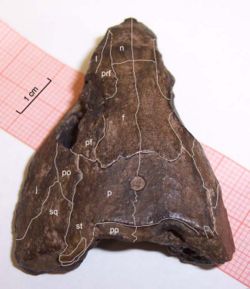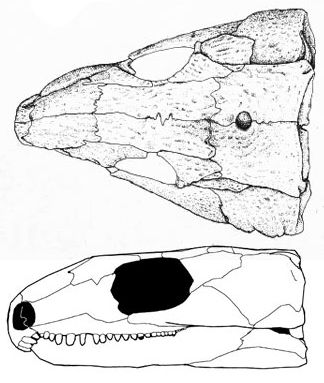R. texana, R. prima
 |
| Facsimile of type specimen of R. texana in oblique lateral view.
|
 |
| Facsimile of type specimen of R. texana in posterodorsal view.
|
Captorhinidae : Concordia + (Protocaptorhinus + (Rhiodenticulatus + (Saurorictus + (Captorhinus + (Captorhinikos + (Labidosaurus + Moradisaurinae)))))) + * : Romeria texana + Romeria prima)
Romeria is a genus of small single-tooth-rowed captorhinids. Two species are currently recognized: R. texana, known from two partial skulls and one poorly preserved postcranial skeleton, and R. prima known from one skull with associated forelimbs, all of which come from the Lower Permian red beds of North Texas.
Scientific History: The type species R. texana was discovered during field collections of the Museum of Comparative Zoology in the in the second half of the 1930s. Its description was published in 1937 and is based on one single cranium whithout braincase. In 1973 a juvenile individual, collected together with material of the microsaur Pantylus, was attributed to that species.
The circumstances of discovery of the second species, R. prima, are not documented. R. prima was first described in 1973 on the basis of one single, almost complete skull and a few postcranial bones. Since 1973 no new material of Romeria has been found by scientific collectors.
Characteristics of the genus: Romeria is caracterized by a unique composition of features that are present in other basal eureptiles rather than by distinct apomorhies. Its pineal foramen, the opening in the center of the skull table, is very large, relative to skull size, as seen in Protocaptorhinus and Concordia. In other respects the skull of Romeria is quite similar to that of more basal eureptile taxa such as Protorothyris or Concordia: it is rather lightly built, has large orbitae compared to skull size, numerous denticles on the palatal bones, a bilaterally embayed posterior margin of the skull roof, and supratemporals that, in dorsal view, project anteromedially into the posterolateral corners of the parietals. However Romeria shows the typical captorhinid traits such as the lost of the tabular bone, the down-curved premaxilla, or the absence of large teeth on the transverse flange of the pterygoid.
Type species: The structure of Romeria texana's skull corresponds primarily to the characteristics of the genus. Therfore only description of the dentition is given here. All teeth have the shape of simple cones. The anteriormost premaxillary teeth are the largest in these bones. Posteriorly they decrease in size rapidly. The anteriormost maxillary teeth are similar in size to the posterior premaxillary teeth but become larger posteriorly to reach maximum size at the 6th position. Posterior to that postiton they become successively smaller again. Unfortunately the juvenile postcranial skeleton mentioned above is enclosed in a nodule of ironstone, being very resistant to efforts of preparation. Therefore nothing is known about the postcranium of R. texana.
Second species: R. prima differs from R. texana in having a much shorter anterior process of the prefrontal bone. The dentition resembles that of R. texana with the exception of that R. prima has two less premaxillary teeth and that the teeth are generally more gracile. Besides those differences the skull structure of both species of Romeria is nearly identical. Unfortunately little is known about the palate of R. prima. However, is seems quite plausible that it closely resembles that of R. texana including the shagreen dentition.
In contrast to R. texana also the forelimbs of R. prima are known. Admittedly, these bones are rather poorly preserved. As far as one can judge they show no major differences to that of other basal generalized amniotes.
Validity of the genus: Recently reasonable doubts are casted on the validity of the genus since no unequivocal apomorhies are included in its definition. There is possibility that such apomorphies could be discovered by further examination of the postcranial type material of R. prima. Because such new findings might not be made in the type species R. texana probably both names will have to be declared nomina dubia and a new genus will have to be erected on the basis of the type material of R. prima subsequently.
Below follow succinct accounts on the recognized species of Romeria.
CLARK, J. and CARROLL, R.L. (1973): Romeriid Reptiles from the Lower Permian. Bulletin of the Museum of Comparative Zoology 144 (5): 353-408
MODESTO, S.P. (1998): New information on the skull of the Early Permian reptile Captorhinus aguti. PaleoBios 18 (2/3): 21-35
PRICE, L.I. (1937): Two new cotylosaurs from the Permian of Texas. Proceedings of the New England Zoölogical Club 16: 97-102
Zidane 25 May 2008
